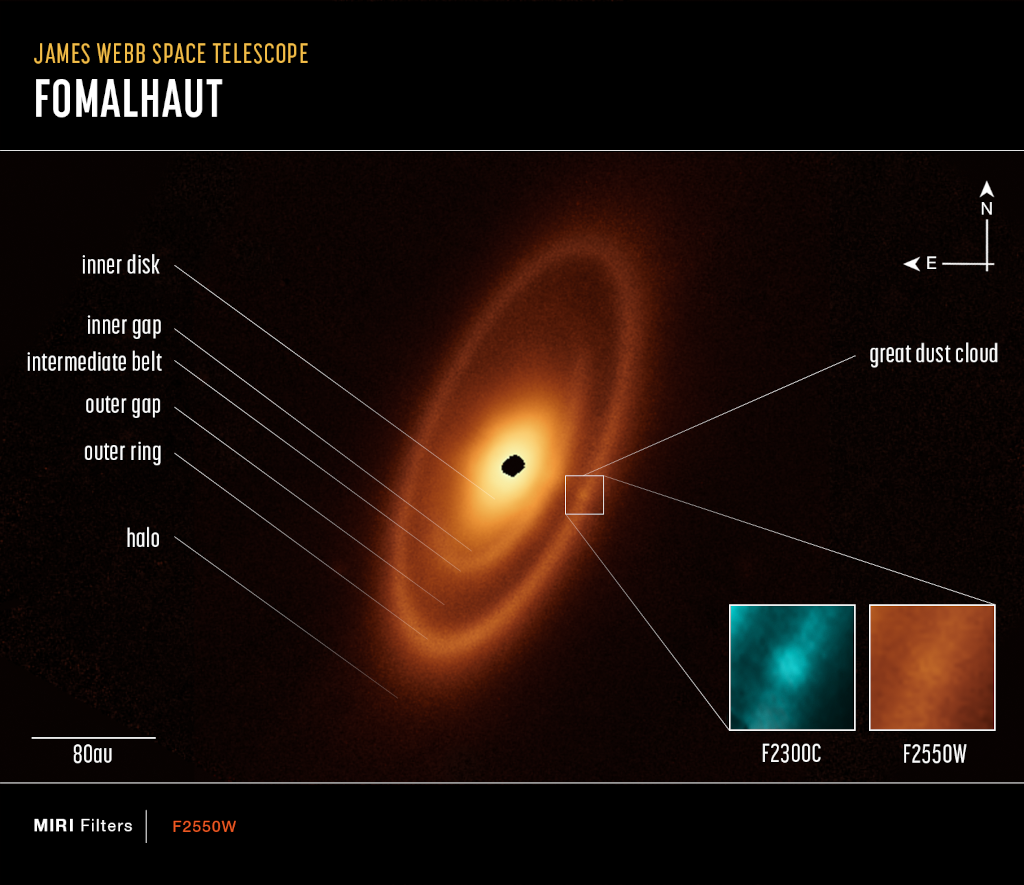2023年5月11日
Fomalhaut’s Dusty Debris Disk
Image Credit: NASA, ESA, CSA, Processing: András Gáspár (Univ. of Arizona), Alyssa Pagan (STScI), Science: A. Gáspár (Univ. of Arizona) et al.
Explanation: Fomalhaut is a bright star, a 25 light-year voyage from planet Earth in the direction of the constellation Piscis Austrinus. Astronomers first noticed Fomalhaut’s excess infrared emission in the 1980s. Space and ground-based telescopes have since identified the infrared emission’s source as a disk of dusty debris surrounding the hot, young star related to the ongoing formation of a planetary system. But this sharp infrared image from the James Webb Space Telescope’s MIRI camera reveals details of Fomalhaut’s debris disk never before seen, including a large dust cloud in the outer ring that is possible evidence for colliding bodies, and an inner dust disk and gap likely shaped and maintained by embedded but unseen planets. An image scale bar in au or astronomical units, the average Earth-Sun distance, appears at the lower left. Fomalhaut’s outer circumstellar dust ring lies at about twice the distance of our own Solar System’s Kuiper Belt of small icy bodies and debris beyond the orbit of Neptune.
Tomorrow’s picture: Halley dust
北落师门的尘埃碎片盘
影像提供: NASA, ESA, CSA, 影像处理: András Gáspár (Univ. of Arizona), Alyssa Pagan (STScI), 科学内容提供: A. Gáspár (Univ. of Arizona) et al.
说明: 位于南鱼座方向的北落师门(Fomalhaut),是一颗距离我们25光年航程的明亮恒星。天文学家在1980年代,首次注意到北落师门有超量的红外辐射。后续的太空及地面望远镜观测,确定了红外辐射的源头是环拱这颗炽热年轻恒星的尘埃碎片盘,而且这个拱星盘正在形成行星系统。这幅由韦伯太空望远镜的中红外光相机所拍摄的清晰红外光影像,呈现了北落师门碎片盘之前所未见的细致结构,包括外环里、可能是天体碰撞证据的大尘埃云,以及可能是由内嵌不可见行星所塑造和维持的内尘埃盘及间隙。位在这幅影像左下角的比例尺,是以地球与太阳的平均距离(au、天文单位)为单位。北落师门的外尘埃环与母星的距离,大约是我们太阳系柯伊伯(凯伯)带的2倍;而位在海王星轨道外头的柯伊伯带,则是小型冰质天体和碎片的家园。
明日的图片: Halley dust







